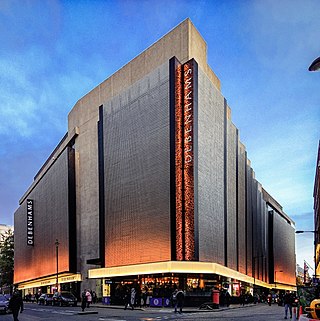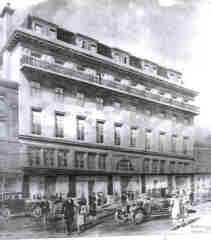Related Research Articles

A dividend is a distribution of profits by a corporation to its shareholders. When a corporation earns a profit or surplus, it is able to pay a portion of the profit as a dividend to shareholders. Any amount not distributed is taken to be re-invested in the business. The current year profit as well as the retained earnings of previous years are available for distribution; a corporation is usually prohibited from paying a dividend out of its capital. Distribution to shareholders may be in cash or, if the corporation has a dividend reinvestment plan, the amount can be paid by the issue of further shares or by share repurchase. In some cases, the distribution may be of assets.

Harrods is a British luxury department store located on Brompton Road in Knightsbridge, London, England. It is owned by Harrods Ltd, a company currently owned by the state of Qatar via its sovereign wealth fund, the Qatar Investment Authority. The Harrods brand also applies to other enterprises undertaken by the Harrods group of companies, including Harrods Estates, Harrods Aviation and Air Harrods. Recognised as one of the world's leading department stores, it is visited by 15 million people per year.

Debenhams plc was a British department store chain operating in the United Kingdom, Denmark and the Republic of Ireland, and is still operating as a franchise in seven Middle East countries. It was founded in 1778 as a single store in London and grew to 178 locations across those countries, also owning the Danish department store chain Magasin du Nord. In its final years, its headquarters were within the premises of its flagship store in Oxford Street, London. The range of goods sold included middle-to-high-end clothing, beauty, household items, and furniture.

Game Retail Limited is a British video game retailer, owned by Frasers Group since June 2019.

GUS plc was a FTSE 100 retailing, manufacturing and financial conglomerate based in the United Kingdom. GUS was an abbreviation of Great Universal Stores, the company's name before 2001, while it was also known as the Glorious Gussies amongst stockbrokers. The company started out as Universal Stores, a mail order business created by the Rose family. In 1931, Isaac Wolfson joined the mail order company and would, through a series of takeovers, turn it into a retail, manufacturing and financial conglomerate, becoming Europe's biggest mail order firm and with over 2,700 physical stores. His son, Leonard Wolfson, followed him as chairman, to be succeeded by his nephews David Wolfson (1996–2000) and Victor Barnett (2000–2002). During the 1980s, the business divested much of its physical retail and manufacturing subsidiaries under Leonard Wolfson to concentrate on mail order, property and finance. In October 2006, the company was split into two separate companies: Experian which continues to exist, and Home Retail Group which was bought by Sainsbury's in 2016.

Frederick & Nelson was a department store chain in the northwestern United States, based in Seattle, Washington. Founded in 1891 as a furniture store, it later expanded to sell other types of merchandise. The company was acquired by Marshall Field & Company in 1929. By 1980, the Frederick & Nelson chain had expanded to 10 stores in two states. The company went out of business in 1992. Its former Seattle flagship store building is now occupied by the flagship Nordstrom store.

House of Fraser and Frasers are a British department store chain with 29 locations across the United Kingdom, part of Frasers Group. It was established in Glasgow, Scotland in 1849 as Arthur and Fraser. By 1891, it was known as Fraser & Sons. The company grew steadily during the early 20th century, and after the Second World War a large number of acquisitions transformed the company into a national chain.

Comet Electricals Limited, trading as Comet, is an online electrical retail chain based in the United Kingdom. The company sells consumer electronics and white goods, along with related products and services. Its predecessor, under the same brand name, pioneered the concept of the out-of-town discount warehouse in the United Kingdom.
Owen Owen was a Liverpool-based operator of department stores in the United Kingdom and Canada. Beginning with a drapery shop in Liverpool, a chain of department stores was built up, often by taking over rival retailers. The company remained under Owen / Norman family control until the 1980s, and the brand ceased to be used in 2007.
Army & Navy Stores was a department store group in the United Kingdom, which originated as a co-operative society for military officers and their families during the nineteenth century. The society became a limited liability company in the 1930s and purchased multiple independent department stores during the 1950s and 1960s. In 1973, the Army and Navy Stores group was acquired by House of Fraser. In 2005, the remaining Army & Navy stores were refurbished and re-branded under the House of Fraser nameplate. House of Fraser itself was acquired by Icelandic investment company, Baugur Group, in late 2006, and then by Sports Direct on the 10 August 2018.
Frasers Group plc is a British retail, sport and intellectual property group, named after its ownership of the department store chain House of Fraser.
Wright's Biscuits was established in 1790 as L Wright & Son, in South Shields. In the 1930s they implemented intensive factory methods for production and became a national supplier of biscuits and cakes, and a leading employer in Tyne and Wear. They also ran a large chain of grocery stores under various names, and controlled fellow grocery chain Moores Stores. The business became part of James Goldsmith's Cavenham Foods group in 1971.

H. Binns, Son & Co. was a chain of department stores based in Sunderland, later purchased and absorbed by House of Fraser.

Barkers of Kensington was a department store in Kensington High Street, Kensington, London. It began as a small drapery business, John Barker & Company, founded by John Barker and James Whitehead in 1870. Barkers grew rapidly to become one of London's largest and most well-known department stores.
Keddies was a small chain of department stores in Essex, England, with its flagship store in a prime location in Southend High Street. The business had a national reputation, being recognised in The Fashion Handbook, appearing on the side of a Matchbox model 17C bus and being one of the retailers that fought to remove Retail Price Maintenance. Keddies closed for business on 26 February 1996 after going into administration.
Chiesmans was a department store group based in Lewisham, London. The business was established in 1884 as a general draper, expanding to become the largest department store in south-east London and operator of a network of branches stretching from Essex to the Isle of Wight. The group was acquired by House of Fraser in 1976. The former Lewisham flagship store closed in 1997.
Drapery Trust formed in 1925 by Clarence Hatry, a notorious British financier. He had made his fortune in speculating on oil stocks, and had convinced investors to promote department stores and bring them under the management of a retail conglomerate. The business was acquired by Debenhams in 1927 and was run as a subsidiary until the 1970s.
E Dingle & Co was a department store chain with its flagship store in Plymouth, England. It is now part of House of Fraser group.

Plummer Roddis was a chain of department stores based in the South of England which was acquired by the Drapery Trust, before being absorbed by its parent company Debenhams.
References
- ↑ "Chips". The Building News & Engineering Journal. 82: XVI. 28 March 1902.
- ↑ "St John's Stratford E15 - Timeline (1866-1881)" . Retrieved 1 November 2014.
- ↑ 1896 Kelly Trade Directory
- ↑ "Victorian values". Financial Times. Retrieved 1 November 2014.
- ↑ "Automaton - The Newham Story". Archived from the original on 20 December 2014. Retrieved 1 November 2014.
- ↑ cashewnut.me.uk/Geneology/HermannFleuryJunior.php
- ↑ "New Companies & Issues". Truth. 2 April 1894. p. 263-264.
- ↑ Stock Exchange Year Book. Bank of England. 1924. p. 2577.
- ↑ "Lost_Hospitals_of_London" . Retrieved 1 November 2014.
- ↑ "Seax - Catalogue: D/BC 1/4/12/1587 Building plan: Addition to Messrs J.R. Roberts and Co.'s shop No. 12 Nelson street Lewis Frederick" . Retrieved 1 November 2014.
- ↑ Otago Daily times 26/8/1899 page 8
- ↑ "English News". The Chemist & Druggist. Vol. 60. 26 April 1902. p. 650.
- ↑ "Miscellaneous Companies". The Economist. 60 (3060): 630. 19 April 1902.
- ↑ "The Stock Exchange Year Book". 1924. p. 2577.
{{cite magazine}}: Cite magazine requires|magazine=(help) - ↑ "New Buildings in London". The Builder. 132 (4385): 296. 18 February 1927.
- ↑ "Ravens of Southend". pinterest.co.uk/pin/750904937881857188/. Retrieved 4 July 2022.
- ↑ The New Dawn. 1963. p. 293.
- ↑ "West Ham: Industries | British History Online".
- ↑ "Company:J R Roberts Ltd". House of Fraser Archive @ University of Glasgow. Retrieved 25 May 2021.
- ↑ "Southend Ironworks supporters celebrating survival of hub". Evening Echo. 2 March 2024.
51°32′31″N0°00′07″E / 51.542°N 0.002°E